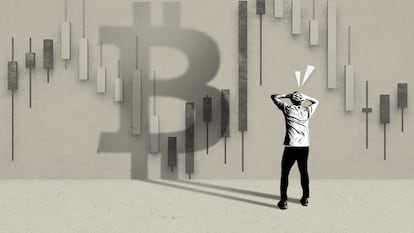‘Crypto-panic’ grips markets after Luna crash: Why are investors fleeing?
The digital currency’s value has gone from $20 billion to nearly zero in a matter of days, and bitcoin has shed 17% in under a week

The future may be too distant a place for some cryptocurrency investors. The collapse of many digital currencies in recent days is sowing doubts among many of those who predicted a bright future in which cryptocurrencies would replace traditional money and break the monopoly of central banks. The virtual disappearance of Luna, the star of one of the biggest fiascos in the industry – its value plummeted from $20 billion to nearly zero in just a few days – has left a trail of victims among investors. It has also spread to the main cryptocurrencies: bitcoin shed 17% in five days, and ethereum, the second most-important cryptocurrency, lost 23%.
Why are they falling?
The trigger for the crisis was the fact that Luna’s sister currency, the stablecoin TerraUST, lost its peg to the US dollar. This stable currency was associated with the greenback by means of an algorithm that has been shown to be ineffective, and which immediately caused a domino effect that has wiped out Luna and infected other cryptocurrencies due to a loss of confidence. Enrique Moris, a professional investor in the stock market and cryptocurrencies expert, sees the effect as normal. “Panic has spread and logically the entire market has been infected. If I may make a bad comparison, if tomorrow Facebook or Apple fell 99%, the same thing would happen and people would rethink their investments in other technology firms.” Moris believes that over time the market will make distinctions. “That this has happened to Luna does not mean that it will happen to the rest of the cryptocurrencies. People are selling bitcoin even though it has nothing to do with it,” he says.
Is it the beginning of the end?
All together, cryptocurrencies are worth $1.2 trillion, according to CoinMarketCap, so despite the setback, they still have a capitalization equivalent to that of online retail giant Amazon. Bitcoin is being traded for around $28,000, its lowest levels since the end of 2020. The recent crash, therefore, is a dint on its credibility but does not signal the end. In fact, bitcoin fell by 80% in 2018, a higher percentage than now. Later, the cryptocurrency was able to fully recover and went on to set new highs. Its defenders are clinging to those precedents in the midst of the current selling panic, although history does not have to repeat itself. But even if it manages to bounce back and return to new highs in the future, many investors will have lost their money along the way, because as the economist John Maynard Keynes once pointed out, “the markets can remain irrational longer than you can remain solvent,” that is, there may be people who need the money to cover expenses or who sell because they consider the drop excessive.
In times of difficulty, one of the most repeated war cries among small investors who bet on cryptocurrencies is to hold, that is, to weather the storm without selling. Moris maintains that the Luna case is a lesson in this regard: “Holding for the next 10 years on the premise that tomorrow you will earn more money if you are patient does not work in the world of crypto, because there are projects that can fall by 99%, as is the case with Luna.” A lack of financial education is in certain cases behind the large losses of small savers, he believes. “There are people who are new to the world of investment, and just because a project is among the 10 largest, they take it for granted that tomorrow it will be worth more,” says Moris.
Correction or collapse?
The ups and downs of bitcoin and other cryptocurrencies are not new. Since their birth more than a decade ago, the difficulty in determining their real value has caused strong oscillations. In the beginning, the strong revaluations helped support the legend that it was a relatively simple way to multiply your savings. But past benefits do not guarantee future ones. There are unconfirmed expectations about their future use, and certain doses of FOMO (fear of missing out) among small investors. There is a huge division of opinion among the experts. There are those who believe that the only reason why the value of cryptocurrencies keep rising is that someone else keeps buying them, and others who see in them a reserve that is only in its infancy. When bitcoin hit highs near $68,000 in November 2021, the latter view seemed reinforced, but now the opposite is true.
What about those who have lost money?
The thousands of small investors who entrusted their money to Luna or TerraUST have no means of recovering what they lost. Cryptocurrencies are now high-risk assets moving in something akin to a financial Wild West. And the messages of those who have seen their accumulated savings of months or years evaporate in a few days are flooding online forums like Twitter or Reddit. The case might indeed encourage greater interest by the authorities to regulate its operation. The US Treasury Secretary, Janet Yellen, has recently made such a request. And the European Union is finalizing regulation that should be ready by the end of the year.
Tu suscripción se está usando en otro dispositivo
¿Quieres añadir otro usuario a tu suscripción?
Si continúas leyendo en este dispositivo, no se podrá leer en el otro.
FlechaTu suscripción se está usando en otro dispositivo y solo puedes acceder a EL PAÍS desde un dispositivo a la vez.
Si quieres compartir tu cuenta, cambia tu suscripción a la modalidad Premium, así podrás añadir otro usuario. Cada uno accederá con su propia cuenta de email, lo que os permitirá personalizar vuestra experiencia en EL PAÍS.
¿Tienes una suscripción de empresa? Accede aquí para contratar más cuentas.
En el caso de no saber quién está usando tu cuenta, te recomendamos cambiar tu contraseña aquí.
Si decides continuar compartiendo tu cuenta, este mensaje se mostrará en tu dispositivo y en el de la otra persona que está usando tu cuenta de forma indefinida, afectando a tu experiencia de lectura. Puedes consultar aquí los términos y condiciones de la suscripción digital.
More information
Últimas noticias
There is as much life left to discover on planet Earth as that which is already known
Dozens presumed dead, around 100 injured in fire at Swiss Alps bar during New Year’s celebration
Is porn for women different from conventional porn? We spoke to those who make it
Cartagena de Indias is sinking: What can the city do to mitigate it?
Most viewed
- Sinaloa Cartel war is taking its toll on Los Chapitos
- Reinhard Genzel, Nobel laureate in physics: ‘One-minute videos will never give you the truth’
- Oona Chaplin: ‘I told James Cameron that I was living in a treehouse and starting a permaculture project with a friend’
- David King, chemist: ‘There are scientists studying how to cool the planet; nobody should stop these experiments from happening’
- Why the price of coffee has skyrocketed: from Brazilian plantations to specialty coffee houses











































